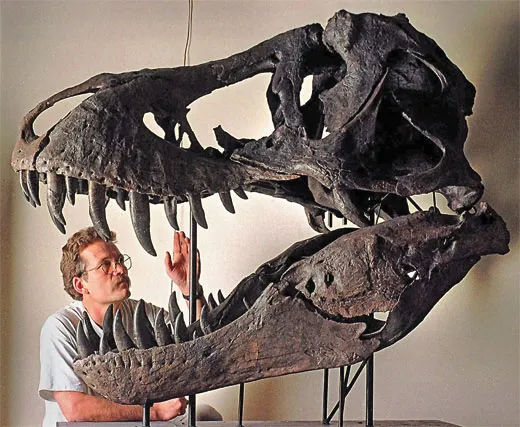The Tyrannosaurus Rex’s Dangerous and Deadly Bite
The dinosaur had the strongest bite of any land animal – even harder than we previously thought
/https://tf-cmsv2-smithsonianmag-media.s3.amazonaws.com/filer/Phenom-T-rex-bite-631.jpg)
Tyrannosaurus rex has always been recognized as fearsome—the New York Times labeled it the “prize fighter of antiquity” when the first mounted T. rex bones were displayed in 1906—but thanks to two British researchers, it’s now clear that the giant carnivore bit harder than experts had thought. A lot harder.
Karl Bates, a biomechanics expert at the University of Liverpool, and Peter Falkingham, a paleontologist at the Royal Veterinary College, London, and Brown University, acknowledge that measuring the biomechanics of an extinct species “is notoriously difficult and involves numerous assumptions.” But for their assessment of T. rex’s bite, published in Biology Letters, they constructed a three-dimensional digital model of the animal’s skull and reconstructed the relevant jaw musculature, based on anatomical research on birds (which are, after all, living dinosaurs) and crocodilians (the closest living cousins to Dinosauria as a group). Previous assessments relied on extrapolations from crocodile bites or fossil T. rex tooth marks.
When Bates and Falkingham used computer models to simulate T. rex’s bite, the result was “quite surprising,” Bates told us: a maximum bite force of almost 12,800 pounds, about the equivalent of an adult T. rex’s body weight (or 13 Steinway Model D concert grand pianos) slamming down on its prey. That would make T. rex the hardest-biting terrestrial animal ever known. (C. megalodon, an extinct giant shark, bit at an estimated 41,000 pounds; Deinosuchus, an ancient crocodilian, at about 23,000 pounds.) Bates and Falkingham’s figure was two to three times greater than previous estimates, six to seven times greater than the biting force they calculated for the dinosaur Allosaurus and about three and a half times greater than the hardest bite measured in an extant species, an Australian saltwater crocodile.
“The posterior part of the skull that housed the muscles was particularly large,” Bates says. Rare juvenile T. rex skeletons indicate that these dinosaurs were leggy runners with relatively shallow skulls incapable of anchoring muscles that would generate a bite proportional to the adults’. In Bates and Falkingham’s tests, juvenile T. rex bites topped out at about 880 pounds. But as the animal matured, its jaw-closing muscles grew exponentially, to the point where they were huge “even for an animal of its colossal size.”
Young T. rex were still formidable—they just targeted different prey. While the juveniles raced down small game, Bates notes, the adults had the power to bring down megaherbivores such as Edmontosaurus and Triceratops. This phenomenon, called resource partitioning, would have reduced competition between parents and offspring—a big evolutionary advantage. As if T. rex needed it.
/https://tf-cmsv2-smithsonianmag-media.s3.amazonaws.com/accounts/headshot/RileyBlack.png)

/https://tf-cmsv2-smithsonianmag-media.s3.amazonaws.com/accounts/headshot/RileyBlack.png)